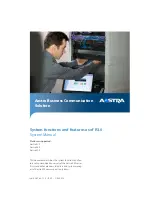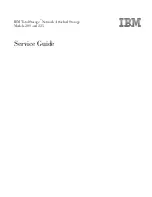
1-22
System Overview
System Power
The server may be configured with up to three 450-Watt power supplies for maximum
system power of 600 Watts. Each supply has autoranging input 50/60 Hz and
automatically switches between the following input voltage ranges:
!
100-127 VAC at 50/60 Hz; 7.6 A maximum current
!
200-240 VAC at 50/60 Hz; 3.8 A maximum current
All output grounds connect to the power supply chassis and to earth ground through the
AC line cord. Each supply has:
!
Individual AC input line cord that plugs into the external side of the power supply
!
Isolating device on each DC output so that the failure of one supply does not affect
the operation of the others
!
Cooling fan integral with each power supply enclosure. The fan circuit implements
fan failure detection.
In a system, power is drawn equally from all supplies installed. A four processor system
with two power supplies can be fully loaded (all drive bays and add-in board slots
filled). The power supplies use a forced current-sharing technique that ensures the
supplies share within 10 percent at full load. In a high-access system with three power
supplies, the additional supply gives redundancy, because the load is redistributed if one
supply fails. Also with the third power supply installed all the power supplies are now
hot-swappable and can be easily installed or removed from the server without turning
system power off.
Peripheral Bays
The system supports a variety of standard PC AT-compatible peripheral devices. The
chassis includes these peripheral bays:
!
A 3.5-inch front panel bay for mounting the standard 3.5" diskette drive (supports
720 KB and 1.44 MB diskette media)
!
Two 5.25-inch removable media
front panel bays for mounting half-height 5.25-inch
peripheral devices: optional tape drives and optional additional CD ROM drive, etc.
!
A front panel bay for mounting the standard CD-ROM drive.
!
One standard and one optional hot-swap SCSI hard disk drive bay for mounting up
to ten SCSI hard disk drives (five disk drives per bay) in easily removable drive
carriers. Each drive has a set of two lights to indicate the fault or other status: power-
on (green LED), activity (green LED, and fault (yellow LED).
Note:
The SCSI hard disk drive bays contain a hot-swap back
panel that require an 80-pin single connector attachment (SCA)
connector on the drives that you install.
Summary of Contents for Express5800/140Hb
Page 1: ... S e r v i c e G u i d e EXPRESS5800 140Hb ...
Page 2: ......
Page 3: ... S e r v i c e G u i d e EXPRESS5800 140Hb ...
Page 10: ...viii Contents ...
Page 18: ...xvi Using This Guide ...
Page 48: ...1 30 System Overview ...
Page 64: ...2 16 Setting Up the System Figure 2 10 Connecting the AC Power Cord to the Server ...
Page 98: ...3 28 Configuring Your System ...
Page 101: ......
Page 176: ...4 76 Disassembly and Reassembly ...
Page 200: ...5 24 Problem Solving ...
Page 201: ...6 Illustrated Parts Breakdown Exploded View Field Replaceable Units ...
Page 211: ...A Technical Specifications Server Unit ...
Page 214: ...A 4 Technical Specifications ...
Page 220: ...B 6 Interrupt Request PCI IRQ Device I O Port Address Assignments ...
Page 231: ...D ROMPilot BIOS Error Codes ROMPilot BIOS Error Codes ...
Page 234: ...D 4 ROMPilot BIOS Error Codes ...
Page 235: ...E Connectors Overview External Device Connector Pin Information ...
Page 250: ...10 Glossary ...
Page 256: ...Index 4 ...
Page 257: ...xx ...
Page 258: ... 456 01547 000 ...
















































